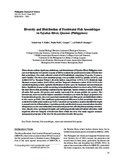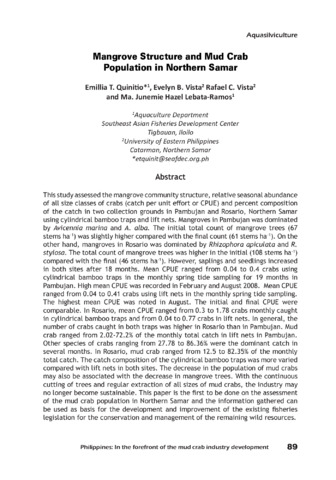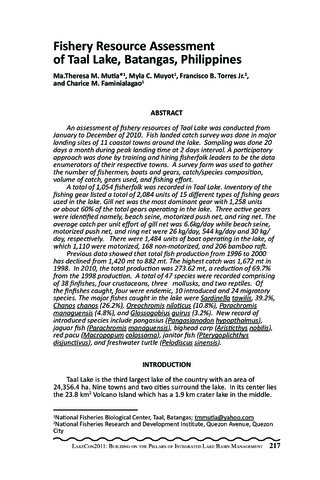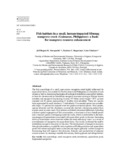Diversity and distribution of freshwater fish assemblages in Tayabas River, Quezon (Philippines)
- Global styles
- MLA
- Vancouver
- Elsevier - Harvard
- APA
- Help

Download URL
philjournalsci.dost.gov.phDate
2013Page views
2,836ASFA keyword
AGROVOC keyword
Metadata
Show full item record
Share
Abstract
Three stream sections (upstream, midstream, and downstream) of Tayabas River, Philippines were surveyed during the wet and dry seasons of 2010 to evaluate the poorly known status of freshwater fish assemblages. The study collected a total of 1,070 individuals comprising 15 species, 13 genera, and 8 families. The three most abundant groups were poeciliids (61.85%), gobiids (26.16%), and cichlid (5.51%). Shannon-Weiner’s diversity indices ranged from 1.270 to 2.171. Relatively high Shannon evenness indices (0.653–0.846) and low Simpson’s dominance values (0.142–0.322) were calculated implying a fairly equitable distribution of niche space for dominant and non-dominant fishes. Significant change on fish assemblage in longitudinal gradient was observed (p<0.05), being the most diverse fish assemblage registered in the upstream. Species richness is mostly composed of native fish species (10 species) and mainly represented by stream gobiids (six species). The downstream, however, had the highest cumulative abundance, in which the larger proportion was from introduced species. Also, wet season had considerably more fish species and individuals relative to dry season (p<0.05). This significant spatio-temporal differences in fish assemblage data were evaluated by multivariate analyses (p<0.05). Canonical correspondence analysis identified the depth (seasonal water level fluctuations), vegetation growth, and dissolved oxygen concentrations (in order of importance) as the most influential environmental parameters affecting fish assemblage structure. Also, climatic stress (prolonged drought) and anthropogenically-induced habitat alteration could negatively affect the integrity of freshwater fishes within the river. The study suggests extensive management programs of the river for the protection of native fish species.
Suggested Citation
Paller, V. G. V., Corpuz, M. N. C., & Ocampo, P. P. (2013). Diversity and distribution of freshwater fish assemblages in Tayabas River, Quezon (Philippines). Philippine Journal of Science , 142(1), 55-67. http://hdl.handle.net/10862/2236
Type
ArticleISSN
0031-7683Collections
- Journal Articles [1229]
Related items
Showing items related by title, author, creator and subject.
-
Mangrove structure and mud crab population in northern Samar
Quinitio, Emilia T. ; Vista, Evelyn B.; Vista, Rafael C.; Lebata-Ramos, Ma. Junemie Hazel
; Vista, Evelyn B.; Vista, Rafael C.; Lebata-Ramos, Ma. Junemie Hazel  (Aquaculture Department, Southeast Asian Fisheries Development Center, 2017)
This study assessed the mangrove community structure, relative seasonal abundance of all size classes of crabs (catch per unit effort or CPUE) and percent composition of the catch in two collection grounds in Pambujan and ...
(Aquaculture Department, Southeast Asian Fisheries Development Center, 2017)
This study assessed the mangrove community structure, relative seasonal abundance of all size classes of crabs (catch per unit effort or CPUE) and percent composition of the catch in two collection grounds in Pambujan and ... -
Series: Summary of Proceedings No. 1/2013;
Fishery resource assessment of Taal Lake, Batangas, Philippines
Mutia, Ma. Theresa M.; Muyot, Myla C.; Torres Jr., Francisco B.; Faminialagao, Charice M. (PCAARRD-DOST, 2013)An assessment of fishery resources of Taal Lake was conducted from January to December of 2010. Fish landed catch survey was done in major landing sites of 11 coastal towns around the lake. Sampling was done 20 days a month ... -
Fish habitats in a small, human-impacted Sibunag mangrove creek (Guimaras, Philippines): a basis for mangrove resource enhancement
The fish assemblage of a small, open access mangrove creek highly influenced by aquaculture farms, was studied for the first time in the Philippines as a baseline of such system as well as examining the degree of ecological ...




